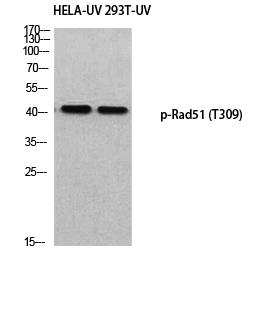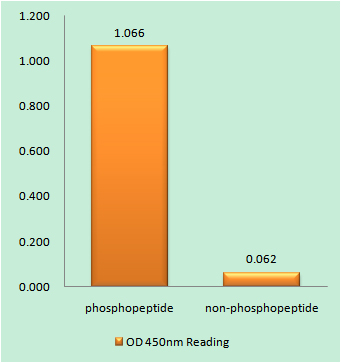
Catalog: KA1506C
Size
Price
Status
Qty.
96well
$470.00
In stock
0
Add to cart


Collected


Collect
Main Information
Reactivity
Human, Mouse
Applications
ELISA
Conjugate/Modification
Phospho
Detailed Information
Storage
2-8°C/6 months,Ship by ice bag
Modification
Phospho
Detection Method
Colorimetric
Related Products
Antigen&Target Information
Gene Name:
RAD51
show all
Other Name:
DNA repair protein RAD51 homolog 1 ;
HsRAD51 ;
hRAD51 ;
RAD51 homolog A ;
HsRAD51 ;
hRAD51 ;
RAD51 homolog A ;
show all
Background:
disease:Defects in RAD51 are associated with breast cancer (BC) [MIM:114480].,function:May participate in a common DNA damage response pathway associated with the activation of homologous recombination and double-strand break repair. Binds to single and double stranded DNA and exhibits DNA-dependent ATPase activity. Underwinds duplex DNA and forms helical nucleoprotein filaments.,PTM:Phosphorylated. Phosphorylation of Thr-309 by CHEK1/CHK1 may enhance association with chromatin at sites of DNA damage and promote DNA repair by homologous recombination.,similarity:Belongs to the recA family.,similarity:Belongs to the recA family. RAD51 subfamily.,similarity:Contains 1 HhH domain.,subcellular location:Colocalizes with RAD51AP1 to multiple nuclear foci upon induction of DNA damage.,subunit:Interacts with BRCA1, BRCA2 and either directly or indirectly with p53. Interacts with XRCC3, RAD54L and RAD54B. Part of a complex with RAD51C and RAD51B. Interacts with RAD51AP1 and RAD51AP2. Interacts with CHEK1/CHK1, and this may require prior phosphorylation of CHEK1. Interacts with the MND1-PSMC3IP heterodimer (By similarity). Interacts with OBFC2B.,tissue specificity:Highly expressed in testis and thymus, followed by small intestine, placenta, colon, pancreas and ovary. Weakly expressed in breast.,
show all
Function:
M phase, double-strand break repair via homologous recombination, recombinational repair, DNA metabolic process,DNA replication, DNA-dependent DNA replication, DNA unwinding during replication, DNA repair, double-strand break repair, DNA recombination, mitotic recombination, protein complex assembly, response to DNA damage stimulus, cell cycle, meiosis, meiosis I, reciprocal meiotic recombination, positive regulation of macromolecule metabolic process, cell cycle process, cell cycle phase, DNA geometric change, DNA duplex unwinding, cellular response to stress,macromolecular complex subunit organization, positive regulation of nucleobase, nucleoside, nucleotide and nucleic acid metabolic process, regulation of DNA metabolic process, positive regulation of DNA metabolic process, regulation of DNA ligation, positive regulation of DNA ligation, positive regulation of nitrogen compound metabolic process,protein oligomerization, protein homooligomerization, meiotic cell cycle, M phase of meiotic cell cycle, macromolecular complex assembly, protein complex biogenesis,
show all
Cellular Localization:
Nucleus . Cytoplasm . Cytoplasm, perinuclear region. Mitochondrion matrix . Chromosome . Cytoplasm, cytoskeleton, microtubule organizing center, centrosome . Colocalizes with RAD51AP1 and RPA2 to multiple nuclear foci upon induction of DNA damage (PubMed:20154705). DNA damage induces an increase in nuclear levels (PubMed:20154705). Together with FIGNL1, redistributed in discrete nuclear DNA damage-induced foci after ionizing radiation (IR) or camptothecin (CPT) treatment (PubMed:23754376). Accumulated at sites of DNA damage in a SPIDR-dependent manner (PubMed:23509288). Recruited at sites of DNA damage in a MCM9-MCM8-dependent manner (PubMed:23401855). Colocalizes with ERCC5/XPG to nuclear foci in S phase (PubMed:26833090). .
show all
Signaling Pathway
Reference Citation({{totalcount}})
Catalog: KA1506C
Size
Price
Status
Qty.
96well
$470.00
In stock
0
Add to cart


Collected


Collect
Recently Viewed Products
Clear allPRODUCTS
CUSTOMIZED
ABOUT US
Toggle night Mode
{{pinfoXq.title || ''}}
Catalog: {{pinfoXq.catalog || ''}}
Filter:
All
{{item.name}}
{{pinfo.title}}
-{{pinfo.catalog}}
Main Information
Target
{{pinfo.target}}
Reactivity
{{pinfo.react}}
Applications
{{pinfo.applicat}}
Conjugate/Modification
{{pinfo.coupling}}/{{pinfo.modific}}
MW (kDa)
{{pinfo.mwcalc}}
Host Species
{{pinfo.hostspec}}
Isotype
{{pinfo.isotype}}
Product {{index}}/{{pcount}}
Prev
Next
{{pvTitle}}
Scroll wheel zooms the picture
{{pvDescr}}


















